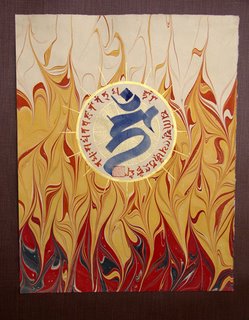
'GBH' asked
on the blog about this form of the seed syllable aṃ which is an image in the Japanese Wikipedia commons. The text accompanying it is in Japanese but it appears the the image was scanned from a book called 悉曇章の研究 (and is therefore a breach of copyright!)
This is simply a variety Siddhaṃ. It looks like it was either done with a Chinese Calligraphy brush or is designed to look that way. Note that even contemporary Siddhaṃ calligraphy can vary quite widely in style.

Compare with my pen style 'a' (left, and
here) - the shape is the same: a shape like a number 3 linked by a mid-height line to a vertical stroke on the right. The contemporary a in Devanāgarī is similar as well:
अं. The dot above the aṃ is the basic anusvāra which indicates nasalisation of the vowel. Anusvāra (anu + svāra) means after-sound, or following sound. Often with bīja mantras the anusvāra is exchanged for the chandra-bindu (moon and dot) which has the same phonetic effect, but which involves a more elaborate symbollism.


 'GBH' asked
'GBH' asked  Compare with my pen style 'a' (left, and
Compare with my pen style 'a' (left, and 